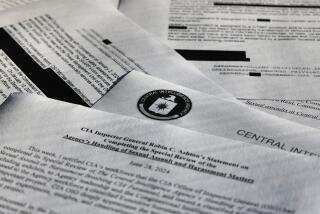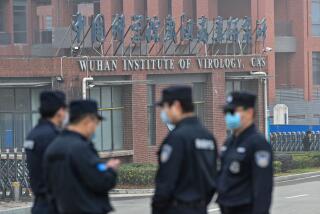Intelligence Analysts Whiffed on a ‘Curveball’
- Share via
WASHINGTON — Prewar claims by the United States that Iraq was producing biological weapons were based almost entirely on accounts from a defector who was described as “crazy” by his intelligence handlers and a “congenital liar” by his friends.
The defector, code-named “Curveball,” spoke with alarming specificity about Iraq’s alleged biological weapons programs and fleet of mobile labs. But postwar investigations showed that he wasn’t even in the country at times when he claimed to have taken part in illicit weapons work.
Despite persistent doubts about his credibility, Curveball’s claims were included in the Bush administration’s case for war without so much as a caveat. And when CIA analysts argued after the war that the agency needed to admit it had been duped, they were forced out of their jobs.
The disclosures about Curveball and the extensive role he played in corrupting U.S. intelligence estimates on Iraq were included in a devastating report released Thursday by a commission established by President Bush to evaluate U.S. intelligence on weapons of mass destruction.
The 601-page document is a sweeping assessment of U.S. intelligence failures that identifies breakdowns in dozens of cases involving multiple countries and terrorist organizations.
But in many ways, Curveball’s story is the centerpiece of the report, a cautionary tale told in excruciating detail to highlight failures that plagued U.S. spy agencies at almost every step in the intelligence process -- from collection to analysis to presentation to policymakers.
U.S. intelligence agencies’ reliance on Curveball and their failure to scrutinize his claims are described in the report as the “primary reason” that the CIA and other spy agencies “fundamentally misjudged the status of Iraq’s [biological weapons] programs.” No other episode is explored in as much detail, or recounted with as much evident dismay.
“Worse than having no human sources,” the commission said, “is being seduced by a human source who is telling lies.”
Curveball even influenced assessments in areas where he claimed no inside knowledge, the commission said. One analyst told the panel that Curveball’s descriptions of biological weapons activity in Iraq “pushed” chemical weapons experts to be more aggressive in their judgments. “Much of the CW confidence was built on the BW confidence,” the analyst said.
Curveball’s identity has never been publicly revealed. His code name and the role he played in leading U.S. spy agencies to assess that Iraq possessed biological weapons was first described in an article in the Los Angeles Times in March 2004. The commission’s report describes Curveball as an Iraqi chemical engineer who defected at a time when U.S. and other spy agencies were desperate for new sources on Iraq’s weapons programs, after U.N. inspectors had left the country in 1998. The CIA never had access to Curveball. Instead, he was controlled by Germany’s intelligence service, which passed along the information it collected to the United States through the Defense Intelligence Agency, a Pentagon spy agency that handled information from Iraqi defectors.
Between January 2000 and September 2001, the report said, the DIA disseminated “almost 100 reports” from Curveball, who was seen as a valuable new source. Among his most alarming claims was that Iraq had assembled a fleet of mobile labs to manufacture biological weapons and evade detection.
The reports triggered a flurry of escalating U.S. intelligence assessments on Iraq, even though the DIA “did not even attempt to determine Curveball’s veracity,” according to the report. Curveball’s claims gained new currency after the Sept. 11 attacks, as the Bush administration adopted a policy of preempting international threats and turned its focus to Iraq.
Curveball’s claims were crucial to the case for war. An October 2002 National Intelligence Estimate that concluded Iraq “has” biological weapons was “based almost exclusively on information obtained” from Curveball, according to the report.
Four months later, when then-Secretary of State Colin L. Powell made a presentation to the United Nations, he showed illustrations of Iraq’s alleged bioweapons labs and described an accident in which 12 Iraqis had died operating one of the vehicles. Curveball was the main source for both assertions. Concerns about Curveball’s credibility were never conveyed to Powell or other administration officials, the commission found.
But there were problems with Curveball’s claims at an early stage. Some CIA officials noted that Curveball’s memory showed significant “improvement” as he pursued a European immigration deal and deteriorated when it was granted.
In May 2000, a Defense Department official assigned to the CIA was allowed to meet with Curveball, apparently to examine the source physically to see whether he bore signs of having survived a biological weapons accident or had been vaccinated for exposure to such agents.
The evaluation was “inconclusive,” according to the commission. But the official expressed concern that Curveball had a “hangover” during their meeting and “might be an alcoholic.” Further, the official was surprised that Curveball spoke excellent English because the Germans had said he didn’t speak the language.
By early 2001, the CIA was getting messages from German intelligence that Curveball was “out of control” and could not be located. Some of Curveball’s information was contradicted by other intelligence. His description of a depot for the weapons labs didn’t match surveillance images, which showed a wall where Curveball said vehicles were entering and exiting.
As war approached, new problems surfaced. Before Powell’s presentation, the CIA pressed for permission to speak directly with Curveball. The head of one of the agency’s divisions arranged a lunch with a German intelligence official.
The German official discouraged the idea, saying, “You don’t want to see him because he’s crazy,” according to the commission report. The German went on to suggest that Curveball had suffered a nervous breakdown, that speaking with him would be “a waste of time,” and that he might be a “fabricator.”
Agency officials dispute what happened next, in the commission’s telling. Several officers in the CIA’s clandestine service described meetings and conversations in which they warned senior agency officials of Curveball’s credibility problems.
One officer said she was told by then-Deputy Director of Operations James L. Pavitt that judgments about Curveball “should be made by analysts.” Another recalled warning John McLaughlin, then deputy director of the CIA, that Curveball might be a fabricator, only to have McLaughlin say, “Oh, my! I hope that’s not true.”
Finally, about midnight before the day of Powell’s U.N. presentation, an agency officer described a telephone conversation with then-CIA Director George J. Tenet in which the officer warned against relying on Curveball. “Tenet replied with words to the effect of ‘yeah, yeah,’ and that he was ‘exhausted,’ ” the commission’s report said.
Pavitt told the commission he was aware of “handling problems” with Curveball but did not know Curveball was the dominant source for biological weapons assessments. McLaughlin and Tenet told the panel that they did not recall receiving those warnings about Curveball.
Tenet, McLaughlin and Pavitt all left the CIA last year.
The commission report revealed details about problems with other prominent prewar claims. The CIA asserted that Iraq was importing aluminum tubes to be used as centrifuges in a nuclear weapons program, although authorities have since concluded they were for conventional rockets.
An allegation that Iraq was seeking to acquire uranium from Niger was based on “transparently forged documents” purporting to show a contract between the countries, the commission concluded. There were “flaws in the letterhead, forged signatures, misspelled words, incorrect titles for individuals and government entities,” the report said.
The contract document also referred to an alleged meeting “that took place on ‘Wednesday, July 7, 2000,’ even though July 7, 2000, was a Friday,” the report said.
All of these assertions unraveled, but none in more embarrassing fashion than the case built on Curveball’s accounts.
After the invasion, intelligence officials tracked down Iraqis who Curveball had claimed were his co-workers in the biological weapons program. All denied there was a mobile biological weapons program, and none “even knew who Curveball was,” the commission found.
Curveball said the program began in 1995, but family members and associates said that he had been fired from his position that year, and that he was out of the country for much of the following four-year period.
Although Curveball had said the deadly accident he witnessed had taken place in 1998, he “was not even in Iraq at that time, according to information supplied by family members and later confirmed by travel records,” the commission found.
When CIA officers finally got direct access to Curveball in May 2004, he was “unwilling or unable” to explain discrepancies in his account, and any remaining questions about his lack of reliability “were removed,” the commission said.
The panel challenged one persistent suspicion about Curveball: that his deception was the result of coaching by the Iraqi National Congress, an organization led by Ahmad Chalabi that had spent years urging the overthrow of Saddam Hussein’s regime. The panel found that at least two national congress defectors were fabricators, but said it was “unable to uncover any evidence that the INC or any other organization was directing Curveball.”
Long after the invasion, the CIA resisted acknowledging that Curveball was a phony and that its prewar claims about Iraq’s weapons programs were wrong, the commission said. One analyst who argued in late 2003 that Curveball had lied was “read the riot act” by his director, accused of “making waves” and ultimately forced to leave the office.
Another analyst who urged the agency to issue a reassessment of Iraq’s chemical weapons program was “told to leave.”
The agency rescinded all of its intelligence reports that were based on Curveball in May 2004.
More to Read
Sign up for Essential California
The most important California stories and recommendations in your inbox every morning.
You may occasionally receive promotional content from the Los Angeles Times.











